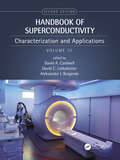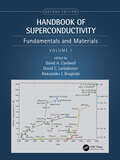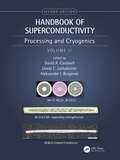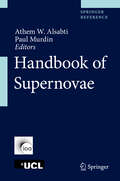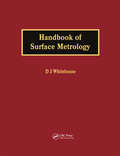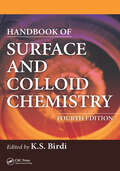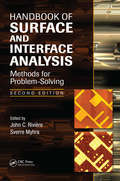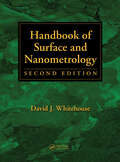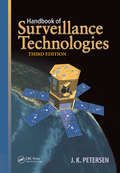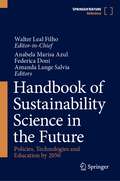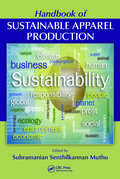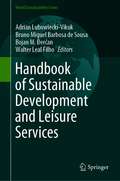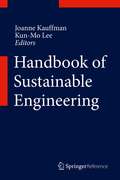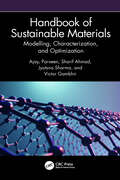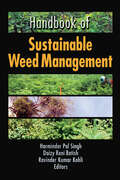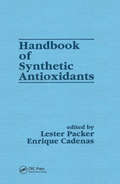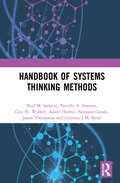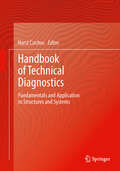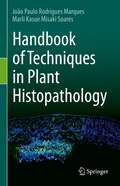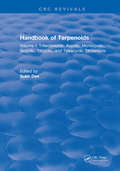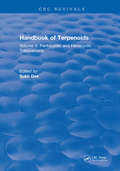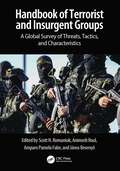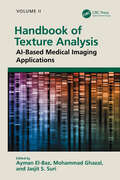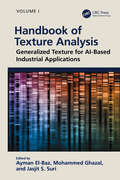- Table View
- List View
Handbook of Superconductivity: Characterization and Applications, Volume Three
by David A. Cardwell David C. Larbalestier Aleksander I. BraginskiThis is the last of three volumes of the extensively revised and updated second edition of the Handbook of Superconductivity. The past twenty years have seen rapid progress in superconducting materials, which exhibit one of the most remarkable physical states of matter ever to be discovered. Superconductivity brings quantum mechanics to the scale of the everyday world. Viable applications of superconductors rely fundamentally on an understanding of these intriguing phenomena and the availability of a range of materials with bespoke properties to meet practical needs.While the first volume covers fundamentals and various classes of materials, the second addresses processing of these into various shapes and configurations needed for applications, and ends with chapters on refrigeration methods necessary to attain the superconducting state and the desired performance. This third volume starts with a wide range of methods permitting one to characterize both the materials and various end products of processing. Subsequently, diverse classes of both large scale and electronic applications are described. Volume 3 ends with a glossary relevant to all three volumes. Key Features: Covers the depth and breadth of the field Includes contributions from leading academics and industry professionals across the world Provides hands-on familiarity with the characterization methods and offers descriptions of representative examples of practical applications A comprehensive reference, the handbook is suitable for both graduate students and practitioners in experimental physics, materials science, and multiple engineering disciplines, including electronic and electrical, chemical, mechanical, metallurgy and others.
Handbook of Superconductivity: Fundamentals and Materials, Volume One
by David A. CardwellThis is the first of three volumes of the extensively revised and updated second edition of the Handbook of Superconductivity. The past twenty years have seen rapid progress in superconducting materials, which exhibit one of the most remarkable physical states of matter ever to be discovered. Superconductivity brings quantum mechanics to the scale of the everyday world where a single, coherent quantum state may extend over a distance of metres, or even kilometres, depending on the size of a coil or length of superconducting wire. Viable applications of superconductors rely fundamentally on an understanding of this intriguing phenomena and the availability of a range of materials with bespoke properties to meet practical needs. This first volume covers the fundamentals of superconductivity and the various classes of superconducting materials, which sets the context and background for Volumes 2 and 3. Key Features: Covers the depth and breadth of the field Includes contributions from leading academics and industry professionals across the world Provides hand-on guidance to the manufacturing and processing technologies A comprehensive reference, this handbook is suitable for both graduate students and practitioners in experimental physics, materials science and multiple engineering disciplines, including electronic and electrical, chemical, mechanical, metallurgy and others.
Handbook of Superconductivity: Processing and Cryogenics, Volume Two
by David A. CardwellThis is the second of three volumes of the extensively revised and updated second edition of the Handbook of Superconductivity. The past twenty years have seen rapid progress in superconducting materials, which exhibit one of the most remarkable physical states of matter ever to be discovered. Superconductivity brings quantum mechanics to the scale of the everyday world where a single, coherent quantum state may extend over a distance of metres, or even kilometres, depending on the size of a coil or length of superconducting wire. Viable applications of superconductors rely fundamentally on an understanding of this intriguing phenomena and the availability of a range of materials with bespoke properties to meet practical needs. While the first volume covers the fundamentals of superconductivity and the various classes of superconducting materials, Volume 2 covers processing of the desired superconducting materials into desired forms: bulks, films, wires and junction-based devices. The volume closes with articles on the refrigeration methods needed to put the materials into the superconducting state. Key Features: Covers the depth and breadth of the field Includes contributions from leading academics and industry professionals across the world Provides hands-on guidance to the manufacturing and processing technologies A comprehensive reference, the handbook is suitable for both graduate students and practitioners in experimental physics, materials science, and multiple engineering disciplines, including electronic and electrical, chemical, mechanical, metallurgy and others.
Handbook of Supernovae
by Paul Murdin Athem W. AlsabtiThis reference work gathers all of the latest research in the supernova field areas to create a definitive source book on supernovae, their remnants and related topics. It includes each distinct subdiscipline, including stellar types, progenitors, stellar evolution, nucleosynthesis of elements, supernova types, neutron stars and pulsars, black holes, swept up interstellar matter, cosmic rays, neutrinos from supernovae, supernova observations in different wavelengths, interstellar molecules and dust. While there is a great deal of primary and specialist literature on supernovae, with a great many scientific groups around the world focusing on the phenomenon and related subdisciplines, nothing else presents an overall survey. This handbook closes that gap at last. As a comprehensive and balanced collection that presents the current state of knowledge in the broad field of supernovae, this is to be used as a basis for further work and study by graduate students, astronomers and astrophysicists working in close/related disciplines, and established groups.
Handbook of Surface Metrology
by David J. WhitehouseWritten by the leading authority in the subject, Handbook of Surface Metrology covers every conceivable aspect of measuring and characterizing a surface. Focusing both on theory and practice, the book provides useful guidelines for the design of precision instruments and presents data on the functional importance of surfaces. It also clearly explains the essential theory relevant to surface metrology. The book defines most terms and parameters according to national and international standards. Many examples and illustrations are drawn from the esteemed author's large fund of groundbreaking research work. This unparalleled, all-encompassing "metrology bible" is beneficial for engineering postgraduate students and researchers involved in tribology, instrumentation, data processing, and metrology.
Handbook of Surface and Colloid Chemistry
by K. S. BirdiThis new edition of the Handbook of Surface and Colloid Chemistry informs you of significant recent developments in the field. It highlights new applications and provides revised insight on surface and colloid chemistry's growing role in industrial innovations. The contributors to each chapter are internationally recognized experts. Several chapter
Handbook of Surface and Interface Analysis: Methods for Problem-Solving, Second Edition
by John C. Rivière Sverre MyhraThe original Handbook of Surface and Interface Analysis: Methods for Problem-Solving was based on the authors' firm belief that characterization and analysis of surfaces should be conducted in the context of problem solving and not be based on the capabilities of any individual technique. Now, a decade later, trends in science and technology appear
Handbook of Surface and Nanometrology
by David J. WhitehouseSince the publication of the first edition, miniaturization and nanotechnology have become inextricably linked to traditional surface geometry and metrology. This interdependence of scales has had profound practical implications.Updated and expanded to reflect many new developments, Handbook of Surface and Nanometrology, Second Edition determines h
Handbook of Surveillance Technologies
by J.K. Petersen Pamela TaylorFrom officially sanctioned, high-tech operations to budget spy cameras and cell phone video, this updated and expanded edition of a bestselling handbook reflects the rapid and significant growth of the surveillance industry. The Handbook of Surveillance Technologies, Third Edition is the only comprehensive work to chronicle the background and curre
Handbook of Sustainability Science in the Future: Policies, Technologies and Education by 2050
by Walter Leal Filho Anabela Marisa Azul Amanda Lange Salvia Federica DoniHumanity will have to cope with many problems in the coming decades: for instance, the world population is likely grow to to 8,8 billion people by 2035. Also, changing climate conditions are negatively affecting the livelihoods of millions of people. In particular, environmental disasters are causing substantial damages to properties. From a social perspective, the inequalities between rich and poor nations are becoming even deeper, and in many countries, conflicts between national and international interest groups are intensifying.The above state of affairs suggest that a broader understanding of the trends which may lead to a more sustainable world is needed, especially those which may pave the way for future developments. In other words, we need to pave the way for sustainable futures.Consistent with this reality, the proposed Encyclopedia of Sustainability Futures aims to identify, document and disseminate ideas, experiences and visions from scientists, member of nongovernmental organisations, decision-makers industry representatives and citizens, on themes and issues which will be important in pursuing sustainable future scenarios. In particular, the publication will focus on scientific aspects, as well as on social and economic ones, also considering matters related to financing and infra-structures, which are important in pursuing a sustainable future.The Encyclopedia of Sustainability Futures will involve the contributing authors in line with theprinciple of co-generation, from across a wide range of disciplines, e.g. education and social sciences, natural sciences, engineering, the arts, languages etc, with papers adopting a long-term sustainability perspective, with a time horizon until 2050. The focus will be on themes which are felt as important in the future, and the chapters are expected to interest and motivate a world audience.This book is part of the "100 papers to accelerate the implementation of the UN Sustainable Development Goals initiative"!
Handbook of Sustainable Apparel Production
by Subramanian Senthilkannan MuthuA hot-button societal issue, sustainability has become a frequently heard term in every industrial segment. Sustainability in apparel production is a vast topic and it has many facets. Handbook of Sustainable Apparel Production covers all aspects of sustainable apparel production including the raw materials employed, sustainable manufacturing proce
Handbook of Sustainable Development and Leisure Services (World Sustainability Series)
by Walter Leal Filho Adrian Lubowiecki-Vikuk Bruno Miguel Barbosa de Sousa Bojan M. ĐerčanThis book reviews empirical and theoretical research on sustainable development in the context of leisure management for communities. Although leading research centers are pursuing interdisciplinary research on leisure in the context of sustainable development, there are still few papers that holistically address the current challenges in this area. In addition, demographic changes have made the promotion of a healthy lifestyle essential. Doing so requires responsible behavior on the part of various stakeholders in this market.This book fills an important gap in the literature and gathers contributions from an interdisciplinary and international team of authors, whose fields of expertise include human geography, management, intersections of sustainability and leisure, behavioral psychology and tourism.
Handbook of Sustainable Engineering
by Joanne Kauffman Kun Mo Lee"The efficient utilization of energy, sustainable use of natural resources, and large-scale adoption of sustainable technologies is the key to a sustainable future. The Handbook of Sustainable Engineering provides tools that will help us achieve these goals". Nobel Prize Winner Dr. R.K. Pauchauri, Chairman, UN Intergovernmental Panel on Climate Change As global society confronts the challenges of diminishing resources, ecological degradation, and climate change, engineers play a crucial role designing and building technologies and products that fulfil our needs for utility and sustainability. The Handbook of Sustainable Engineering equips readers with the context and the best practices derived from both academic research and practical examples of successful implementations of sustainable technical solutions. The handbook's content revolves around the two themes, new ways of thinking and new business models, including sustainable production, products, service systems and consumption while addressing key assets based on new materials, optimized resource management, and new energy sources. Contributions reflect a focus on state-of-the art insights into employing smart materials, recycling e-waste, water utilization, solar cells, product lifecycles, transportation and reverse manufacturing. Supportive of this, underlying issues such as engineering education, consumer behaviour and the regulatory climate complete the handbook's comprehensive treatment of the problems and most promising solutions.
Handbook of Sustainable Materials: Modelling, Characterization, And Optimization
by Ajay Parveen Sharif Ahmad Jyotsna Sharma Victor GambhirHandbook of Sustainable Materials presents recent developments in sustainable materials and how these materials interact with the environment. It highlights the recent advancements involved in proper utilization of sustainable materials, including chemical and biological approaches. With chapters written by global experts, the book offers a guide and insights into sustainable materials from a variety of engineering disciplines. Each chapter provides in-depth technical information on the sustainable materials theory and explores synthesis strategies, green materials, and artificial intelligence. The book considers applications in sectors such as aerospace, automobile, and biomedical for rapid prototyping and customized production without negative environmental impacts. It features research outcomes and case studies of optimization and modeling techniques in practice. Features: Presents recent developments in sustainable materials from various engineering fields and industry applications. Emphasizes analytical strategies, computational, and simulation approaches develop innovative sustainable materials. Discusses an artificial intelligence approach, rapid prototyping, and customized production. This book is designed for researchers and professionals working with sustainable materials, clean manufacturing, and environmental impacts.
Handbook of Sustainable Weed Management
by Ravinder Kumar Kohli Harminder Pal Singh Daizy Rani BatishInnovative Strategies for Managing Weeds in an Environmentally Protective MannerSuccessfully meeting the challenge of providing weed control without relying on dangerous chemicals that endanger the ecosystem or human lives, this compendium focuses on management strategies that reduce herbicidal usage, restore ecological balance, and incr
Handbook of Synthetic Antioxidants (Antioxidants In Health And Disease Ser. #3)
by Lester PackerEmphasizes the efficacy of synthetically occurring compounds in the management of free radical-mediated illnesses. The text details the design, development and delivery of therapeutic antioxidants used in the treatment of pathophysiological disorders, from amylotrophic lateral sclerosis (ALS) and multiple sclerosis (MS) to Alzheimer's disease.
Handbook of Systems Thinking Methods
by Jason Thompson Neville A. Stanton Guy H. Walker Paul M. Salmon Natassia Goode Adam Hulme Gemma J.M. ReadThe systems thinking philosophy has become popular in human factors and ergonomics and safety science. These methods are being used to understand and resolve complex societal problems in areas such as transport safety, workplace safety, medication error, disaster management, child abuse, financial crises, terrorism, climate change and public health and wellbeing. This handbook presents practical step-by-step guidance for practitioners and researchers wishing to use these methods to tackle complex problems. Each method includes an example case study which demonstrates how the method can be applied and how the results can be interpreted and translated into practical recommendations. The book presents practical guidance on state-of-the-art systems thinking methods and offers case study applications describing systems thinking methods in novel areas. It explains how to translate the outputs of systems thinking methods in practice and introduces systems thinking with an overview of Human Factors and Ergonomics applications. This book will serve as a great reference for students and engineers in the field of systems engineering, complex systems and the design and development of systems, including ergonomics/human factors and systems engineers, designers, architects, industrial engineers, project management engineers, reliability engineers, risk engineers, software engineers and computer engineers.
Handbook of Technical Diagnostics: Fundamentals and Application to Structures and Systems
by Horst CzichosThis book presents concepts, methods and techniques to examine symptoms of faults and failures of structures, systems and components and to monitor functional performance and structural integrity. The book is organized in five parts. Part A introduces the scope and application of technical diagnostics and gives a comprehensive overview of the physics of failure. Part B presents all relevant methods and techniques for diagnostics and monitoring: from stress, strain, vibration analysis, nondestructive evaluation, thermography and industrial radiology to computed tomography and subsurface microstructural analysis. Part C cores the principles and concepts of technical failure analysis, illustrates case studies, and outlines machinery diagnostics with an emphasis on tribological systems. Part D describes the application of structural health monitoring and performance control to plants and the technical infrastructure, including buildings, bridges, pipelines, electric power stations, offshore wind structures, and railway systems. And finally, Part E is an excursion on diagnostics in arts and culture. The book integrates knowledge of basic sciences and engineering disciplines with contributions from research institutions, academe, and industry, written by internationally known experts from various parts of the world, including Europe, Canada, India, Japan, and USA.
Handbook of Techniques for Aquatic Sediments Sampling
by Alena Mudroch Scott D. MacKnightThis up-to-date revision of a bestseller sets the standard for planning and implementing cost-effective sediment sampling programs. Handbook of Techniques for Aquatic Sediments Sampling, Second Edition is the only comprehensive text on procedures for sampling bottom sediments, suspended sediments, and sediment pore water. Practical guidance is also
Handbook of Techniques in Plant Histopathology
by João Paulo Rodrigues Marques Marli Kasue Misaki SoaresThis handbook presents a compilation of plant histopathology laboratory practices and microscopy techniques for study plant tissues under biotic stress. It will serve as an easy-to-reference material for professors, undergraduate and graduate students and researchers from different areas who work with the interaction between plants and pathogens, whether they are fungi, viruses or bacteria. Besides, it will also help unveil the structural, ultrastructural and histochemical changes induced by plants when challenged by plant pathogens.
Handbook of Terpenoids: Volume I: Triterpenoids
by Sukh DevThis Handbook, pinpoints salient features of known information about Terpenoids in a readily accessible and readable format. Terpenoids have singularly enriched organic chemistry by its variety of structural types, by its wealth ofunexpected reactions, rearrangements and spectral features, and by offering exciting targets for synthesis. Much imaginative experimental work has been invested in exploring their natural pathways. Recent years have revealed an increasingly important biological and ecological role for several of its members.
Handbook of Terpenoids: Volume II
by Sukh DevA compilation of all the known information on terpenoids specifically triterpenoids, is presented in these volumes. The most important available information on a particular compound is discussed, such as its isolation/occurence, available spectral data, and leading references on structural determination. Additionally, triterpenoids synthesis, biosynthesis, proven pharmacological properties, and any known applications are explained. A comprehensive general introduction has been included which surveys the development of triterpenoid chemistry from the beginning to the present. Extremely helpful is the selected list of references to books and reviews dealing with various aspects of triterpenoid chemistry.
Handbook of Terrorist and Insurgent Groups: A Global Survey of Threats, Tactics, and Characteristics
by Animesh Roul Scott N. Romaniuk János Besenyő Amparo Pamela FabeHandbook of Terrorist and Insurgent Groups: A Global Survey of Threats, Tactics, and Characteristics examines the most current and significant terrorist and insurgent groups around the world. The purpose is to create a descriptive mosaic of what is a pointedly global security challenge.The volume brings together conceptual approaches to terrorism, insurgency, and cyberterrorism with substantive and empirical analyses of individual groups, organisations, and networks. By doing so, not only does the coverage highlight the past, present, and future orientations of the most prominent groups, but it also examines and illustrates their key characteristics and how they operate, including key leaders and ideologues. Highlighting specific, individual groups, the chapters collectively present a robust and comprehensive outlook on the current geography of terrorism and insurgency groups operating in the world today.This comprehensive volume brings the collective expertise and knowledge of more than 50 academics, intelligence and security officials, and professionals together, all of whom are considered subject experts in their respective areas of research and practice. The volume is based on both desk-based and fieldwork conducted by experts in these areas, incorporating analyses of secondary literature but also the use of primary data including first-hand interviews on the various groups’ regions of operation, their tactics, and how their ideologies motivate their actions.
Handbook of Texture Analysis: AI-Based Medical Imaging Applications
by Jasjit S. Suri Ayman El-Baz Mohammed GhazalThe major goals of texture research in computer vision are to understand, model, and process texture and, ultimately, to simulate the human visual learning process using computer technologies. In the last decade, artificial intelligence has been revolutionized by machine learning and big data approaches, outperforming human prediction on a wide range of problems. In particular, deep learning convolutional neural networks (CNNs) are particularly well suited to texture analysis. This volume presents important branches of texture analysis methods which find a proper application in AI-based medical image analysis. This book: Discusses first-order, second-order statistical methods, local binary pattern (LBP) methods, and filter bank-based methods Covers spatial frequency-based methods, Fourier analysis, Markov random fields, Gabor filters, and Hough transformation Describes advanced textural methods based on DL as well as BD and advanced applications of texture to medial image segmentation Is aimed at researchers, academics, and advanced students in biomedical engineering, image analysis, cognitive science, and computer science and engineering This is an essential reference for those looking to advance their understanding in this applied and emergent field.
Handbook of Texture Analysis: Generalized Texture for AI-Based Industrial Applications
by Jasjit S. Suri Ayman El-Baz Mohammed GhazalThe major goals of texture research in computer vision are to understand, model, and process texture, and ultimately, to simulate the human visual learning process using computer technologies. In the last decade, artificial intelligence has been revolutionized by machine learning and big data approaches, outperforming human prediction on a wide range of problems. In particular, deep learning convolutional neural networks (CNNs) are particularly well suited to texture analysis. This book examines four major application domains related to texture analysis and their relationship to AI-based industrial applications: texture classification, texture segmentation, shape from texture, and texture synthesis. This volume: Discusses texture-based segmentation for extracting image shape features, modeling and segmentation of noisy and textured images, spatially constrained color-texture model for image segmentation, and texture segmentation using Gabor filters Examines textural features for image classification, a statistical approach for classification, texture classification from random features, and applications of texture classifications Describes shape from texture, including general principles, 3D shapes, and equations for recovering shape from texture Surveys texture modeling, including extraction based on Hough transformation and cycle detection, image quilting, gray level run lengths, and use of Markov random fields Aimed at researchers, academics, and advanced students in biomedical engineering, image analysis, cognitive science, and computer science and engineering, this is an essential reference for those looking to advance their understanding in this applied and emergent field.
